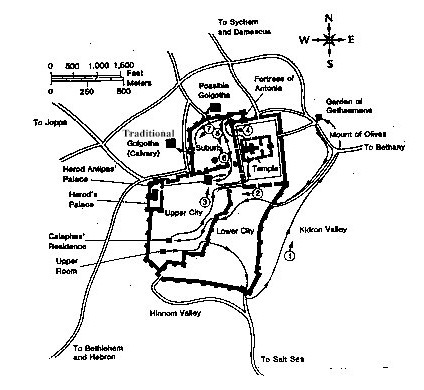 Map of
Jerusalem at time of Christ. Jesus left Upper room and
walked with disciples to Mount of Olives and Garden of
Gethsemane (1), where he was arrested and taken first to
Annas and then to Caiaphas (2). After first trial before
political Sanhedrin at Caiaphas' residence, Jesus was
tried again before religious Sanhedrin, probably at
Temple (3). next, he was taken to Pontius Pilate (4), who
sent him to Herod Antipas (5). Herod returned Jesus to
Pilate (6), and Pilate finally handed over Jesus for
scourging at Fortress of Antonia and for crucifixion at
Golgotha (7). |
|
GETHSEMANE
After Jesus and his disciples had observed the
Passover meal in an upper room in a home in southwest
Jerusalem, they traveled to the Mount of Olives,
northeast of the city. (Owing to various adjustments in
the calendar, the years of Jesus' birth and death remain
controversial. (29) However, it is likely that Jesus was
born in either 4 or 6 BC and died in 30 AD. (11,29)
During the Passover observance in 30 AD, the last Supper
would have been observed on Thursday, April 6 [Nisan 13],
and Jesus would have been crucified on Friday, April 7
[Nisan 14]. (29) ) At nearby Gethsemane, Jesus,
apparently knowing that the time of his death was near,
suffered great mental anguish, and, as described by the
physician Luke, his sweat became like blood. (1)
Although this is a very rare phenomenon, bloody sweat
(hematidrosis or hemohidrosis) may occur in highly
emotional states or in persons with bleeding disorders.
(18,20) As a result of hemorrhage into the sweat glands,
the skin becomes fragile and tender. (2,11) Luke's
descriptions supports the diagnosis of hematidrosis
rather than eccrine chromidrosis (brown or yellow-green
sweat) or stigmatization (blood oozing from the palms or
elsewhere). (18,21) Although some authors have suggested
that hematidrosis produced hypovolemia, we agree with
Bucklin (5) that Jesus' actual blood loss probably was
minimal. However, in the cold night air, (1) it may have
produced chills. TRIALS
Soon after midnight, Jesus was arrested at Gethsemane
by the temple officials and was taken first to Annas and
then to Caiaphas, the Jewish high priest for that year.
|
(1) Between 1 AM and daybreak, Jesus was tried before
Caiaphas and the political Sanhedrin and was found guilty
of blasphemy. (1) The guards then blindfolded Jesus, spat
on him, and struck him in the face with their fists. (1)
Soon after daybreak, presumably at the temple, Jesus was
tried before the religious Sanhedrin (with the Pharisees
and the Sadducees) and again was found guilty of
blasphemy, a crime punishable by death. (1,5)
Roman Trials Since permission for an execution had to come from the governing Romans, (1) Jesus was taken early in the morning by the temple officials to the Praetorium of the Fortress of Antonia, the residence and governmental seat of Pontius Pilate, the procurator of Judea. However, Jesus was presented to Pilate not as a blasphemer but rather as a self-appointed king who would undermine the Roman authority. (1) Pilate made no charges against Jesus and sent him to Herod Antipas, the tetrarch of Judea. (1) Herod likewise made no official charges and then returned Jesus to Pilate. (1) Again, Pilate could find no basis for a legal charge against Jesus, but the people persistently demanded crucifixion. Pilate finally granted their demand and handed over Jesus to be flogged (scourged) and crucified. (McDowell (25) has reviewed the prevailing political, religious, and economic climates in Jerusalem at the time of Jesus' death, and Bucklin (5) has described the various illegalities of the Jewish and Roman trials.) |
| Back | Next |